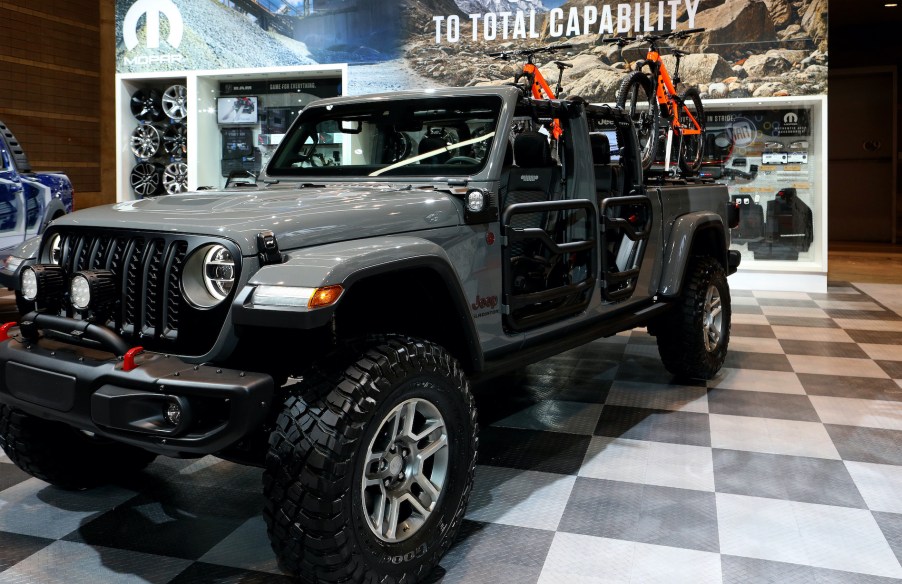
There’s No Reason to Spend $60K on a Jeep Gladiator Mojave
The Jeep Gladiator was one of the most anticipated vehicles of 2019. Then it arrived, and many drivers found that while the interior was insanely cool, that was about all. Not only does the Jeep Gladiator not live up to its name, but it’s plagued by problems.
In such cases, it seems to make sense to upgrade to a higher trim level. The more money you pay, the better the vehicle will be. Right? Motor1 doesn’t seem to think that’s the case with the Mojave Trim. You might pay more money, but it’s still just as lackluster as the lower trims.
What is the Mojave trim?
The Jeep Gladiator, like its older sibling the Wrangler, is geared for the off-road community. With each trim level, it’s geared toward a specific clientele. The Gladiator Rubicon is designed for the mountains. The Overland is filled with tons and tech, and the Mojave trim is for the desert.
If you’re wondering when the Mojave trim hit the showroom since it wasn’t introduced with the other trim levels, the short answer is that this is a late edition. Jeep is trying to compete with the ever-popular Ford F-150 Raptor. Whether Jeep has succeeded remains to be seen, but if you’re looking for a vehicle to race across the desert, the Mojave Gladiator might just be what you’re looking for.
The body has gone through several changes to make it more off-road worthy. It gets a 1-inch-higher ride height, Fox 2.5-inch internal bypass shock absorbers, and cast-iron (instead of aluminum) suspension knuckles. The heavy-duty Dana 44 wide axles on the front and rear have a 10-millimeter wall thickness.
The Mojave Gladiator’s engine isn’t exactly impressive. It’s a 3.6-liter V6 that makes 285 hp and 260 lb-ft. It does just fine off-road, but again, it’s not ideal for a daily driver. In fact, Motor1 reports that you feel each and every bump.
The interior seating is comfortable, but you don’t get much leg room. You also don’t get much in the way of standard features unless you start shelling out some extra money.
What did Motor1 think?
Like the Wrangler, all the things that make the Mojave trim great for off-roading makes it bad for driving on-road. The bypass shock absorbers and cast-iron suspension knuckles make daily driving more than a little irritating.
In the desert, it’s a whole new ball game. Small bumps? No problem. You can sail over them going 50-60 mph easily, although you may get a little whiplash.
Motor1 was far from impressed with the engine, however, and referred to it as ‘wheezy.’ When compared to the Ford F-150 Raptor, the Mojave still has a long way to go.
You don’t get what you pay for in the Jeep Gladiator Mojave
If you like tech, then you won’t like the Mojave. Jeep makes you pay through the nose for extras.
According to Motor1, “Leather seats add $1,475, and a larger 8.0-inch infotainment display costs $1,695 when bundled with navigation and Alpine premium audio. Blind-spot alert and rear parking sensors demand $995, while adaptive cruise control and full-speed forward collision prevention ask a reasonable $795. LED front and rear lighting should be standard given the terrible base halogen headlights, but nope – that’ll be a $1,045 option.”
So the original price for the Mojave is $43,875. By the time you end up buying extra features that are now standard on most vehicles, you’re looking at $59,720. While you might be tempted to just shell out the extra money, you really need to ask yourself if it’s really worth that.
Part of this might be due to price gouging. Thanks to COVID-19 and plants being shut down, dealerships are charging whatever they feel like. So whatever the MSRP is, they’re adding quite a bit to the price. If you’re in the market for a Gladiator, make sure you’re not paying too much, especially for the Mojave configuration.
The base version of the Gladiator is definitely worth every penny, so don’t feel like you should avoid it completely.


